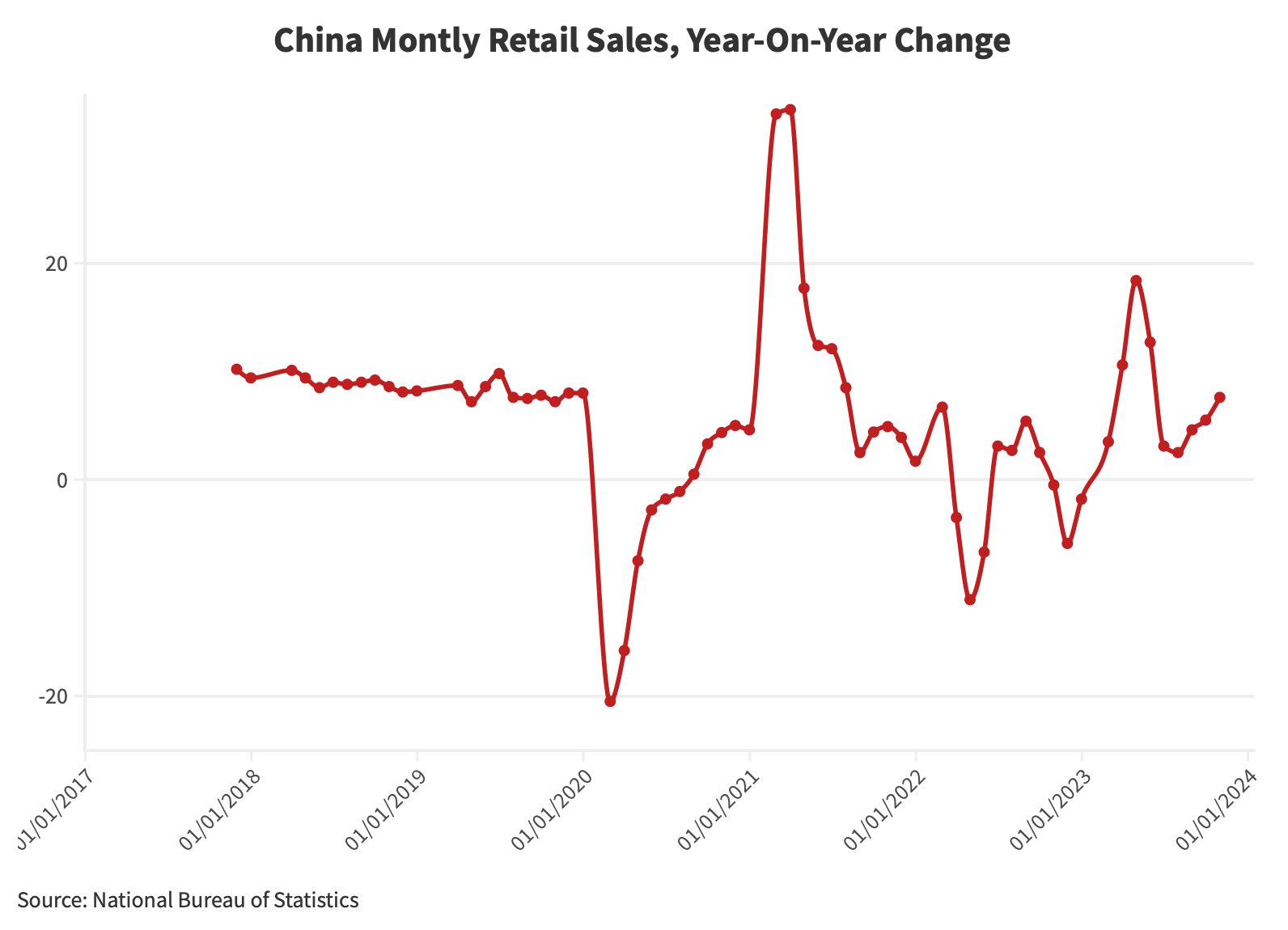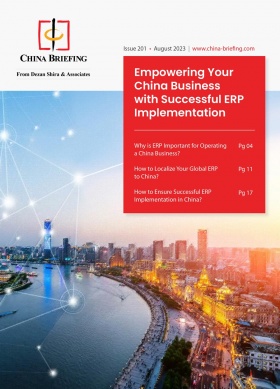China 2023 October Economic Roundup: Retail Sales and Factory Output Exceed Expectations
We break down key data points in the China October economic roundup released by the National Bureau of Statistics. The Chinese economy appears to have ‘bottomed out’ with several indicators outperforming growth expectations. Despite a contraction in export and investment data, there’s a silver lining in consumption and services.
China’s National Bureau of Statistics (NBS) has released the key economic indicators for October 2023, revealing a notable uptick in economic activity.
Industrial output demonstrated accelerated growth, outpacing previous rates, while retail sales exceeded expectations. This positive momentum provides encouragement for an economy that continues to grapple with several areas of weakness.
“The national economy has sustained good momentum of sustained recovery, with major indicators continuing to improve, and overall performance remaining stable,” stated Liu Aihua, an NBS spokesperson, during a press conference accompanying the economic data release on November 15, 2023.
On the other hand, areas such as consumer price index (CPI), foreign investment, and fixed asset investment, have spurred some concerns about the sustanability of China’s growth momentum in the long run, implying that further and more robust support are still needed from the government.
Acknowledging challenges both domestically and internationally, Liu emphasized China’s commitment to implementing targeted and effective macro readjustment in the next stage. The focus will be on expanding domestic demand, bolstering consumer and investor confidence, and mitigating risks.
Moreover, the prospect of stabilized relations between China and the U.S. is expected to enhance economic and trade exchanges, contributing to the steady recovery of both economies, as noted by analysts.
Overview of key economic indicators
In October, China exhibited a mixed economic performance, with retail sales, manufacturing output, and imports surpassing expectations, signaling a modest acceleration in the ongoing recovery. This positive momentum, however, unfolds against the backdrop of a general deceleration of fixed asset investment, and a decline of foreign investment flows.
Services sector shows resilience
On the supply side, the index of services production (ISP) grew 7.7 percent year-on-year in October, a 0.8 percentage points increase from September. The ISP measures the change in price-adjusted output of the service industry in the reporting period relative to the base period.
China’s October economic data also included a breakdown of various service industry segments, including:
- Hospitality and catering, which grew 3 percent year-on-year;
- Transport, storage, and post, up 2 percent year-on-year;
- Information transmission, software, and IT, up 10.9 percent year-on-year.
- Wholesale and retail, up 10 percent year-on-year; and
- Financial integration, up 8 percent year-on-year.
Meanwhile, the operating income of service companies above designated size (those with a main annual business income of over RMB 20 million (approx. US$2.8 million)) grew 7.1 percent year-on-year.
Service business activity indices also recorded an expansion, with the Business Activity Index for Services at 50.1 percent, and the Business Activity Expectation Index for Services at 57.5 percent. A reading of over 50 percent indicates an expansion.
Of these, the business activity indices of industries, such as railway transportation, air transportation, postal services, and telecommunication, broadcast, television, and satellite transmission services, were all above 60 percent, indicating a high level of growth.
Consumption beat expectations
On the consumption side, retail sales of consumer goods in October beat expectations, 7.6 percent year-on-year to reach RMB 4.3 trillion (US$593.7 billion), 2.1 percentage points higher than September. This growth indicates the highest rate in five months, boosted by the extended holiday period at the beginning of October during the Golden Week.

Consumption in certain sectors, such as catering, saw a significant jump in May, whereas others experienced more modest growth:
- Retail sales of goods reached RMB 3.8 trillion (approx. US$6 billion), up 6.5 percent year-on-year; and
- Catering revenue reached RMB 480 billion (approx. US$2 billion), up 17.1 percent.
Meanwhile, retail sales of commodities by businesses above a designated size (annual main business income of over RMB 20 million) grew as it follows:
- Retail sales of sports and entertainment products increased by 14.3 percent year-on-year;
- Retail sales of communication equipment grew 25.7 percent year-on-year;
- Retail sales of automobiles increased by 11.4 percent year-on-year; and
- Retail sales of gold, silver, and jewelry grew 10.4 percent year-on-year.
Meanwhile, online retail sales reached RMB 12.2 trillion (approx. US$1.6 trillion) in October, a year-on-year increase of 11.2 percent, accelerating by 1.5 percentage points from the period from January to April 2023. Of this, online sales of physical goods amounted to RMB 10.3 trillion (US$1.4 trillion), accounting for 26.7 percent of total retail sales this year so far.
Manufacturing output grows
In October, industrial output demonstrated a notable 4.6 percent year-on-year increase, marking a substantial growth of 4.5 percentage points from September and surpassing the anticipated 4.3 percent rise. Month-on-month, the value-add grew by 0.39 percent.
Value-add growth across the three major industries was as follows:
- The mining industry decreased by 9 percent year-on-year;
- The manufacturing industry grew by 5.1 percent year-on-year;
- The production and supply of electricity, heat, gas, and water increased by 5 percent year-on-year; and
- The equipment manufacturing increased by 2 percent year-on-year, 0.7 percent higher than in September, and marking three-consecutive months of positive growth.
The value-add of foreign-funded enterprises grew by 0.9 percent year-on-year, while private enterprises grew by 3.9 percent.
Certain market segments experienced growth booms in October. These were mostly high-growth technology industries, with solar cell production, service robots, and integrated circuits increasing by 62.8 percent, 59.1 percent, and 34.5 percent respectively compared to the same period last year.
High-tech segments continue to drive fixed-asset investment
Fixed asset investment between January and October reached RMB 41.9 trillion (US$5.7 trillion), an increase of 2.9 percent compared to the same period last year, but a decrease of just 0.2 percentage points compared to the January to September period.
By sector, infrastructure investment saw fairly robust growth at 5.9 percent year-on-year, while manufacturing investment grew by 6.2 percent. Real estate development investment, however, declined by 9.3 percent.
Secondary industries experienced the most significant growth in investment, with a 9 percent year-on-year increase. In contrast, the tertiary industries saw a modest uptick of 0.4 percent, while investment in the primary industries declined by 1.3 percent.
High-tech industries continued to attract high levels of investment, growing 11.1 percent year on year. Several high-tech sub-sectors experienced very high levels of growth, including:
- Investment in medical equipment and instrument manufacturing increased by 7 percent;
- Investment in aerospace vehicle and equipment manufacturing increased by 19 percent year-on-year;
- Investment in services for transformation of scientific and technological achievements increased by 3 percent year-on-year; and
- Investment in professional technical services increased by 1 percent year-on-year.
Investment by private companies exhibited a robust growth of 9.1 percent year-on-year, excluding investment in real estate development.
Foreign investment deficit
China marked a significant economic development with its first-ever quarterly deficit in foreign direct investment (FDI), as revealed by the latest balance of payments data. During the July-September period, direct investment liabilities, encompassing a broad measure of FDI that includes foreign companies’ retained earnings in China, stood at a deficit of US$11.8 billion, according to preliminary balance of payments data.
This underscores the pressure of capital outflow and reflects the challenges Beijing faces in attracting overseas companies, particularly in the aftermath of Western governments’ ‘de-risking’ strategies.
Amidst this decline in direct investment liabilities, the number of newly established foreign invested companies (FIEs) sees a notable uptick.. Data from the Ministry of Commerce (MOFCOM) reveals that a total of 37,814 FIEs were established in China during the first three quarters of 2023, marking a robust 32.4 percent year-on-year growth.
It is noteworthy that the structure of foreign investment has also experienced optimization, with double-digit growth observed in key sectors, including:
- High-tech manufacturing;
- Medical equipment manufacturing;
- Electronic and communication equipment manufacturing; as well as
- Research and development (R&D) and design services.
These developments reflect a diversified and resilient pattern within the foreign investment landscape.
Imports rise, but foreign trade remains sluggish
International trade experienced sluggish growth in October, with a mere 0.9 percent increase in overall imports and exports compared to the previous year. Nevertheless, this marks a clear improvement from September when the value was negative by 0.7 percentage points.
The total value of goods imports and exports reached RMB 3.5 trillion (US$483.3 billion). Of this, exports amounted to RMB 1.9 trillion, down 3.1 percent year-on-year, while imports reached RMB 1.5 trillion, a notable increase of 6.4 percent year-on-year. This resulted in a trade surplus of RMB 405.5 billion (US$55.9 billion).
Notably, general trade saw a 1.8 percent year-on-year increase, constituting 64.9 percent of the total value of imports and exports, up by 1.1 percentage points compared to the same period last year. Furthermore, imports and exports by private enterprises grew by 6.2 percent, making up 53.1 percent of the total value, a 3.1 percentage point increase from the same period last year.
In particular, exports of mechanical and electrical products experienced a 2.8 percent growth, contributing to 58.5 percent of the total export value.
How to read October’s data
Analyzing the nuanced October data, experts emphasized the potential constraints of year-on-year figures, considering the influence of holidays and the low base effect in 2022. During the eight-day Golden Week holiday, for example, trips fell short of government estimates, reflecting consumer concerns about job security and income growth in an uncertain employment market. However, the jobless rate, holding steady at 5 percent in October according to NBS data, displayed resilience compared to September.
In the trade sector, amid the overall sluggish scenario attributed to weakened global demand and a subdued economic recovery throughout the year, the concurrent trade slowdown is matched by the Chinese government’s proactive efforts to stimulate the economy. These encompass eased borrowing rules, reduced mortgage rates, and increased infrastructure investments.
Moreover, the release of trade data coincides with ongoing international trade talks, particularly between China and Australia, aiming to revive trade ties and address economic and political tensions impacting trade relationships.
However, challenges persist, evident in the sixth consecutive month of declining exports and a notable decrease in the trade surplus, revealing a complex economic landscape.
Adding to this analysis, the October data nevertheless confirms China’s steady economic recovery, driven by government-initiated investment, a gradual stabilization of external demand, and sustained improvements in consumption. Recent adjustments by the EIU to China’s GDP forecast, raised from 5.2 percent to 5.5 percent, indicate a stronger-than-expected performance in Q3. Government initiatives supporting property developers and the issuance of special government bonds contribute to an anticipated sustained recovery in the fourth quarter.
Nevertheless, market confidence remains fragile, and potential mild shocks could disrupt demand. The low inflation environment creates incentives to postpone consumption, impacting industrial profit, particularly with elevated input prices.
A notable shift arises as China’s FDI flow turned negative for the first time since 1998, prompting foreign investors to reassess their interest in the market. The growing preference for domestic brands and supply chain diversification pursued by Western economies contribute to this trend. While ASEAN countries and India benefit from this shift, intra-Asian trade sees a significant uptick, as showcased by the latest FAI investment data, highlighting growth in equipment manufacturing surpassing the overall headline FAI.
Policies for stimulating growth
In response to the economic landscape observed in October, policymakers have adopted a multifaceted approach to sustain and enhance growth.
The People’s Bank of China (PBOC) adhered to market expectations by maintaining its interest rate during the renewal of maturing medium-term policy loans. This aligns with the broader commitment to providing a supportive monetary environment for economic recovery. The injection of a net RMB 500 billion (US$68.7 billion) via the medium-term lending facility underscores the ongoing dedication to liquidity support, reflecting a proactive stance to mitigate economic headwinds.
The government’s adjustment of the 2023 budget deficit to around 3.8 percent of GDP, up from 3 percent, reflects a fiscal policy geared towards addressing economic challenges. This accommodates the planned issuance of RMB 1 trillion (US$137.10 billion) in sovereign bonds, signaling a commitment to leveraging fiscal tools to bolster economic resilience.
Despite challenges in the property sector, marked by a 9.3 percent decline in year-on-year property investment in January-October, authorities are contemplating additional measures. Discussions revolve around potential liquidity injections using the pledged supplementary lending tool to target and stabilize the property market. This reflects a nuanced and targeted approach to address sector-specific vulnerabilities.
In tandem with these efforts, the Chinese government is also strategically focused on enhancing the attractiveness of the investment environment. An example can be seen in the recently introduced measures to boost foreign investment, ranging from intellectual property rights improvement to facilitating cross-border data flows. These measures, lauded by foreign business organizations, reflect a comprehensive strategy to instill confidence among foreign investors.
Looking ahead, we can also anticipate further cuts in the banks’ reserve requirement ratio (RRR) in the final months of the year – a move that aligns with an overall strategy to enhance liquidity, stimulate lending, and provide additional impetus for economic recovery.
About Us
China Briefing is written and produced by Dezan Shira & Associates. The practice assists foreign investors into China and has done so since 1992 through offices in Beijing, Tianjin, Dalian, Qingdao, Shanghai, Hangzhou, Ningbo, Suzhou, Guangzhou, Dongguan, Zhongshan, Shenzhen, and Hong Kong. Please contact the firm for assistance in China at china@dezshira.com.
Dezan Shira & Associates has offices in Vietnam, Indonesia, Singapore, United States, Germany, Italy, India, Dubai (UAE), and Russia, in addition to our trade research facilities along the Belt & Road Initiative. We also have partner firms assisting foreign investors in The Philippines, Malaysia, Thailand, Bangladesh.
- Previous Article Apostille Convention Officially Takes Effect in China on November 7
- Next Article The 2023 Xi-Biden Meeting: A Summary of the Discussions and Future Trends







